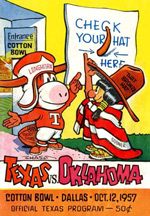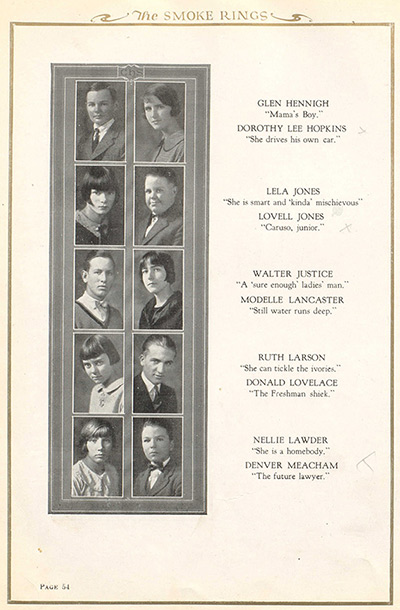Here are 10 things you should know about Dudley Dickerson, born 115 years ago today. He enjoyed a prolific Hollywood career as a character actor.
Tag: Oklahoma
10 Things You Should Know About Howard Da Silva
Here are 10 things you should know about Howard Da Silva, born 112 years ago today. He was a versatile actor, excelling on stage and screen and in dramas, comedies and musicals.
Bohemians in the Attic: In Search of Ruth Larson Hatcher
Our mom used to mention an Aunt Ruth, her mother’s sister, who lived in Taos, New Mexico, and was an artist. We’d met Ruth on a couple of occasions, she assured us, but we had been so young at the time, we had (and still have) no recollection of those encounters.
But as we grew into adulthood and came to more greatly appreciate creative types—bohemians, as they are sometimes called—we began to wonder about Aunt Ruth and to fervently wish we could at the very least see some of her artwork, which Mom had led us to understand would be paintings.
We did an internet search every few years but never turned anything up, in large part because didn’t know her last name (we assumed she’d been married at some point).
We even included a heavily fictionalized version of Aunt Ruth in one entry in Men My Mother Dated and Other Mostly True Tales, the collection of humorous essays and stories we published some years back. In this particular tale, Ruth and her husband lived not in Taos, but in Amarillo, Texas, where they operated a roadside eatery. The story had it that Mom, feeling restless as her senior year in high school approached, was given permission to spend the summer with Aunt Ruth and work as a waitress in the diner.
As the story progresses, Mom meets Jack Kerouac, who is traveling south from Denver with Neal Cassady to visit William S. Burroughs in Mexico City. A mildly fictionalized account of that trip is found in Kerouac’s novel On the Road, but Mom’s encounter with Kerouac isn’t, of course, mentioned there, since it never happened (except in the pages of our book).
In recent years, we’ve become an avid (if entirely amateur) genealogist, digging gleefully into the various branches of our family tree via ancestry.com and other similar sites. But only very recently did we make any serious progress in learning more about Aunt Ruth, who was, it turns out, a citizen of some prominence in Taos, so much so that one Mary Alden penned a 1,000-word profile of her for The Taos News that was published on March 4, 1999, nearly a month after Ruth passed away.
From that profile, we learned much more than we’d ever known about Ruth (which was admittedly next to nothing).
Read More »
A Flapper in the Family?
 When we were kids—eight or nine years old—there was a powdered drink mix (think Tang, but in a variety of flavors) called Keen. We liked the stuff, and Mom probably figured it was no worse for us (and it was much cheaper) than soda (or pop, as we called it in Oklahoma).
When we were kids—eight or nine years old—there was a powdered drink mix (think Tang, but in a variety of flavors) called Keen. We liked the stuff, and Mom probably figured it was no worse for us (and it was much cheaper) than soda (or pop, as we called it in Oklahoma).
We can recall a conversation with our grandmother—Mom’s mom—in which she told us, as we mixed a tasty glass of Keen (which flavor? Let’s say … grape), that, when she was a youth, “keen” was a slang word, the equivalent of “groovy” (this discussion took place in the late 1960s).
Not surprisingly, considering our age at the time, we didn’t find Grandmother’s little story of much interest (though we hold out hope that we were polite enough to at least pretend we did). But now, of course, we do.
 Grandmother was born in 1904, meaning she came of age smack dab in the middle of the Roaring 20s. So, of course (ain’t it always the way?), we’d give our eye teeth to speak to her now about what it was like to be a young adult during the Jazz Age, but alas, she left us some years ago, long before it occurred to us to make the connection, so we never got to have that discussion.
Grandmother was born in 1904, meaning she came of age smack dab in the middle of the Roaring 20s. So, of course (ain’t it always the way?), we’d give our eye teeth to speak to her now about what it was like to be a young adult during the Jazz Age, but alas, she left us some years ago, long before it occurred to us to make the connection, so we never got to have that discussion.
We can’t quite imagine that Grandmother was wild enough in her salad days to qualify for flapper status, but who’s to say? She and Granddad got married in 1929, so she could have spent a few years sowing some wild oats before settling down. Given that she grew up in small-town Oklahoma, though, it seems not all that likely. (That’s Grandmother standing just behind my grandfather in the photo to the left, but that shot was snapped in 1936 or ’37, which would put Grandmother in her early thirties. That’s Mom, age 3 or 4, in the lower left corner).
So, you might ask, what brought on all this spate of musing about a brief conversation regarding 1920s slang that took place more than forty years ago?
We came across the following 1928 recording by Eddie South and His Alabamians, that’s what. The song is “That’s What I Call Keen” (lyrics by Gus Kahn; music by Ted Fiorito
).
That’s What I Call Keen
Look at those eyes; look at those nose.
Look at those hats; look at those clothes.
That’s what I call keen.
Look at that style; isn’t it nice?
Look at that smile; look at it twice.
That’s what I call keen.
When I saw her first, I nearly fainted.
And I’ve been unconscious since we got acquainted.
Look at her now, looking at me.
Isn’t that love, couldn’t you see?
That’s what I call keen.
Corndogs and touchdowns
 We spent the past weekend taking our dad from Oklahoma City down to Dallas for the Red River Rivalry, the Oklahoma-Texas game (we’re talking college football here, don’t you know).
We spent the past weekend taking our dad from Oklahoma City down to Dallas for the Red River Rivalry, the Oklahoma-Texas game (we’re talking college football here, don’t you know).
Dad’s made his way to Big D for the big game every year but three since 1948, which means he’s been on hand for 58 percent of the 106 games played between the two heated rivals—a pretty impressive feat, in our view. The series, which kicked off in 1900, has been played in the Cotton Bowl, on the state fairgrounds (while the State Fair of Texas is underway, mind you) since 1929, and it’s a setting like no other in college football.
The stands are divided at the fifty-yard line—half the stadium’s sporting burnt orange, the other half crimson—and everyone’s out for blood (figuratively speaking, mostly). Dallas sits halfway between Norman, Oklahoma, home to OU, and Austin, Texas, where UT is found, so, aside from those locals who may have scored tickets, it’s an away game for everyone, and the fans behave accordingly (for good and ill).
Our Sooners took care of business in a big way this year—55-17 is an all-out beatdown in this typically competitive game—but we won’t bore you with video highlights from that big win. Those wouldn’t fall within this site’s purview.
Instead enjoy this five-minute roundup of the 1957 contest. The Sooners were 43 wins into their all-time record 47-game winning streak, and though the Longhorns made a strong showing, they would suffer their sixth loss in a row to the Crimson and Cream (OU was really good in the 1950s).
Enjoy the action, and note the fun narration throughout. If you like your football commentary alliterative, this is the clip for you.
P.S. If you missed the latest installment of Pitch Perfect on Monday, don’t fret. It’ll return on October 17. We’ve been dealing with computer issues over the past week, but we’re almost back up to speed.

